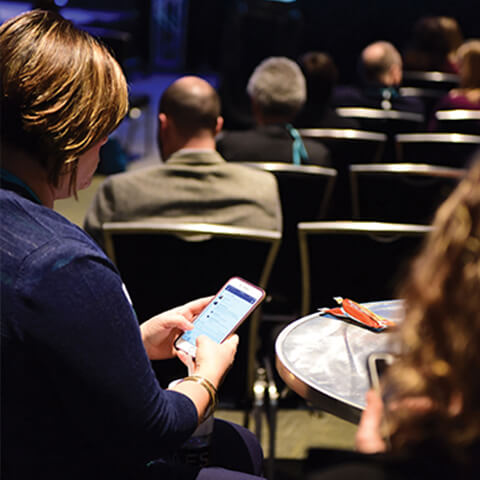As CEO of the event-focused technology company Core-Apps, Jay Tokosch has seen it happen countless times. He’ll sit down with event organizers to run through the analytics he can pluck from their event apps, and they only want to know one thing: How many downloads did we get?
Tokosch estimates that fewer than a third of organizers ever venture beyond that single data point. But he wishes more would. “I don’t think they realize what they can really gain from the analytics we supply to them,” Tokosch said. “There’s a lot your mobile app can tell you that will help you enhance your event, grow your event, and put more focus on certain things for your event.”
‘USAGE IS VERY IMPORTANT’
In recent years, customized event apps have become standard at meetings of all sizes and industries — and considering the benefits to attendees, it’s easy to see why. From schedules to maps, session ratings to note-taking, apps offer many paper-free pluses. But they can also provide more valuable data than many organizers realize.
As Tokosch sees it, stopping at the number of downloads only gives you a paragraph of the full story. “If you have a million people download your app but only 500 of them use it, was it worth it? Did it really meet its purpose?” he said. “Usage is very important. You can glean so many things from usage.”
And usage means more than the number of people who opened the app after downloading it — although that’s certainly valuable information. Usage also covers how people used the app once they were inside it: what they looked at, what they clicked on, where they took notes, which sessions they added to their schedules. That data can reveal which speakers and sessions most engaged your attendees, whether it’s through bookmarks or saved slides or, of course, ratings.
Knowing what was popular helps you start planning for next year, but it can be useful well before then, too. Sander Rosen, director of marketing and communications for the Association of Legal Administrators (ALA), tracks how often each of the 80-some sessions at ALA’s Annual Conference & Expo is bookmarked on ALA’s app, developed by Core-Apps. Although bookmarks don’t provide an exact count of how many people will show up for a given session, they do give Rosen and his team a sense of how popular sessions are relative to each other. “Before the event even starts,” Rosen said, “we know [which sessions] are most likely to need more chairs and more space, and which are going to need a little more love to get people there.”
Rosen also looks at how many times sessions were viewed versus book-marked in the app. Those numbers are sometimes vastly different, and he tries to figure out why. So far he’s taken it to mean that a session’s title attracted people, but something in its description lost them — usually a tone that’s “too sales-y,” he said.
PAYING OFF
Tokosch notes that usage data can even reveal industry trends — useful to both your organization and your sponsors. He mentions one sponsor that had already been tracking industry trends, and used analytics gathered from the event app to confirm its suspicions and even set its marketing budget.
Sponsors also want to know how much exposure they’re getting for their money, and an event app can help with that, too. If a sponsor runs a banner ad in the app, for instance, Tokosch recommends that organizers report how many views and clicks that ad received. Having that data on hand can help you land more sponsorships in the future.
And app analytics can help fine-tune your exhibitor list. Tokosch suggests analyzing which exhibitors had the most bookmarks or the most people routing themselves to their location on the show floor using the app map. That information can help you whittle down exhibitor categories for next year.
At its 2017 Annual Conference in Denver this past April, ALA offered an app-based treasure hunt that sent attendees to 13 VIP exhibitors. Anyone who completed the quest was entered to win a free ticket to next year’s conference. About 300 of ALA’s 1,100 attendees finished the challenge, according to data collected from the app — and “we were pretty thrilled that we got that kind of response,” Rosen said. The VIP exhibitors were, too. Rosen said he’s already had requests from other exhibitors who want to be included in next year’s treasure hunt.
Bob Vaez, CEO of the event-technology platform EventMobi, says his company has been focusing on app data that reveals an attendee’s “journey” throughout an event. Looking at data for individual attendees — when they arrived, whether they came on time, which sessions they checked into, whether they participated in live polls and discussions, even whether they liked the food — “can tell you a whole bunch of new stories that no one has been able to tell before,” Vaez said. It also means you can run trend and segmentation analyses — figuring out whether people who bought a dis-counted ticket, for example, had a different experience than those who paid full price, or whether people from New York tended to participate more than those from Virginia.
If that’s making your head spin, you’re not alone. For event organizers who plan to take deep dives into app-gathered data — and who want to maximize and utilize the information they’re getting — both Vaez and Tokosch recommend hiring an outside analytics consultant or tapping some-one within your company who can help. But Tokosch is quick to add that there’s plenty you can figure out on your own, too. “I’d start with the basic things, which can tell you a lot,” he said. “And 70 percent of [organizers] aren’t look-ing at those basics.”


